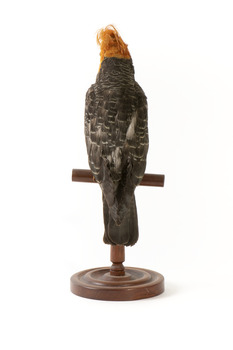Historical information
The Gang-gang Cockatoo can be found throughout much of south-eastern Australia. They reside in mountainous forests and open woodlands, often in small groups or larger flocks at sources of food and water. They eat mainly seeds from native trees and shrubs along with wattles, eucalypts and hawthorns. The Gang-gang Cockatoo is also known to incorporate berries, nuts, fruits and insects to their diet. The sound made by this type of Cockatoo is often described as a rasping screech which resembles the sound of a rusty hinge being moved.This type of call is made when the bird is in flight. These birds also fond of attention and can pick their own feathers if they are bored. The name "gang gang" derives from a New South Wales Aboriginal language, either the Ngunnawal or Wiradjuri.
This specimen is part of a collection of almost 200 animal specimens that were originally acquired as skins from various institutions across Australia, including the Australian Museum in Sydney and the National Museum of Victoria (known as Museums Victoria since 1983), as well as individuals such as amateur anthropologist Reynell Eveleigh Johns between 1860-1880. These skins were then mounted by members of the Burke Museum Committee and put-on display in the formal space of the Museum’s original exhibition hall where they continue to be on display. This display of taxidermy mounts initially served to instruct visitors to the Burke Museum of the natural world around them, today it serves as an insight into the collecting habits of the 19th century.
Significance
This specimen is part of a significant and rare taxidermy mount collection in the Burke Museum. This collection is scientifically and culturally important for reminding us of how science continues to shape our understanding of the modern world. They demonstrate a capacity to hold evidence of how Australia’s fauna history existed in the past and are potentially important for future environmental research.
This collection continues to be on display in the Museum and has become a key part to interpreting the collecting habits of the 19th century.
Physical description
The male Gang Gang Cockatoo is standing stylised on a wooden perch. The Cockatoo has a dark slate-grey coloured body with a scarlet red/orange coloured head with a wispy crest. This specimen stands with its wings positioned to its sides and has round glass bead eyes. The bill has a hooked shape and is horn-coloured. The legs and feet of this specimen are dark grey.




























